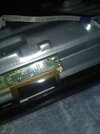Pyjamausamah
New Member
Hi everyone
I'm pretty new to all of this, so please bear with me.
I'm attempting to replace a board that has some ribbon cables bonded/glued to it. I've attached an image showing this. When trying to attach the cables onto the new board, can I just haphazardly spread some conductive glue across the pads on the board, and place the cables on top, or would that end up shorting something? Is some sort of conductive glue a reasonable solution to this? Is there anything a novice would need to keep in mind when doing this?
Any help would be appreciated
Thank you
I'm pretty new to all of this, so please bear with me.
I'm attempting to replace a board that has some ribbon cables bonded/glued to it. I've attached an image showing this. When trying to attach the cables onto the new board, can I just haphazardly spread some conductive glue across the pads on the board, and place the cables on top, or would that end up shorting something? Is some sort of conductive glue a reasonable solution to this? Is there anything a novice would need to keep in mind when doing this?
Any help would be appreciated
Thank you


